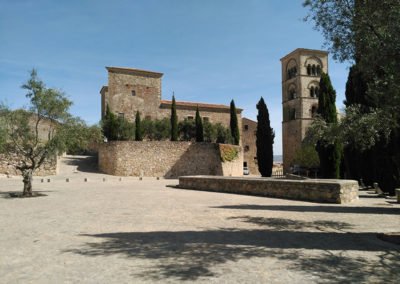Trujillo, Cáceres

Trujillo has been chosen, not only for the scenic beauty of the proposed area, Puerta de La Coria, but for its potential in the development of architectural proposals capable of recovering its deteriorated urban structure. Also doing so without ceasing to satisfy the present needs of the municipality and, taking the rich architectural and constructive tradition as reference of such a remarkable historical context.
The place
Trujillo and its natural environment compose one of the most representative landscapes and historical-artistic spaces of Extremadura and the western Iberian Peninsula. Located to the east of the province of Cáceres, on the axis of the main route from Madrid-Lisbon (A-5), it is founded on a characteristic granite batholith that emerges in the middle of the Cáceres plain. It constitutes a privileged hillock which dominates a landscape full of granite berrocals, meadows of oak trees, river beds and pseudosteppe.
The configuration of this promontory, dominating all its surrounding space, was surely crucial for its formation as an inhabited enclave since prehistoric times, and it continued to be in its process of consolidation and historical evolution, both in Roman and medieval times.
The Historical Complex of Trujillo, formed by the enclosure and expanded by the Wall and extensions from the Late Middle Ages and the beginning of the Modern Era, was declared an Asset of Cultural Interest in 1962. It is a site that extends over the southern outskirts of the hill on which the Castle, formerly the Alcazaba, stands. It is made up of a network of narrow streets irregular in design, adapted to the topography. The town is organized around the Plaza Mayor, a large civic space, representative of the town’s golden era. It stands out both for its size and for the presence of important architectural pieces, such as the Church of San Martín or the palaces of San Carlos, the Toledo Orellana or the Marqués de la Conquista.
In addition to its Historic Site, Trujillo has another 8 items which have also been declared of Cultural Interest, among which the Castle or Alcazaba, the Church of Santa María la Mayor, the Plaza Mayor and its main palaces and manor houses stand out. It also houses an extensive group of buildings included in the inventory of the Historical Heritage of Extremadura.
The Proposal
The current physical configuration of Trujillo’s urban centre, overflowing from the walled enclosure towards the East and the South, makes the handling of the landscape on the northwestern slope, where the wall continues to embrace the urban centre, constitute a unique opportunity to reinforce the relationship of the historical city with the landscape and the territory. The topography and the conditions of sunlight in this area have favoured its maintenance in original natural conditions, with roads embedded between walls and terraces, granite boluses and abundant trees. In addition, the area located within the walls is in this very abandoned area, barely travelled and little used by locals and visitors alike. Recovering part of the ruined farmhouse, improving connectivity between existing public spaces and providing both new uses would revitalize this neighbourhood.
In this framework, the purpose of the competition is the development of a project that would enhance and revalue the two areas mentioned. On the one hand, the layout and design of the area outside the walls, “Parque de la Coria”, a strip of public space along the stretch of wall between the gates of La Coria and the Arco del Triunfo. On the other hand, the treatment of other architectural elements and nearby public spaces.
They want to propose a series of actions aimed at promoting the dissemination and promotion of this area, as part of both the local activity and the tourist circuits of the town. This would encourage visits, which today are very limited to the surroundings of the Plaza Mayor, to this northwestern slope of the walled enclosure. Thus, the solutions must be in any case aimed at facilitating better use and enjoyment of these areas by the local population and visitors, taking into account the landscape, environmental and cultural values and respecting and enhancing the traditional identity of the place.











